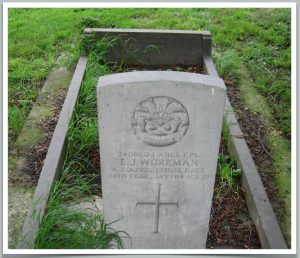1/6th Battalion, North Staffordshire Regiment

Ellis James (Jack) Workman was born in Gloucester in 1889, one of three children born to Elias and Alice Workman.
At the start of the Great War he was employed as a printer, possibly in Stafford, as this is where he attested for four years service in the Territorial Force (TF), on 16 September 1914. However, he gave his mother as next of kin, at 40 Derby Road, Gloucester.
According to his Medal Index Card he was given the Regimental number of 2913, although this was later changed to 240660, as part of a renumbering system for those in TF units.
Territorial Force personnel were not obliged to serve abroad, unless they volunteered. This must have been the case with Jack, as on 5 March 1915 he embarked for France with 1/6th North Staffordshires.
For reasons unknown, he returned home on 13 May 1915 and therefore did not transfer with the battalion to Egypt. It appears likely that he became involved in training and on 16 February 1916 was promoted to Lance Corporal.
He returned to France on 3 July 1916, sailing from Southampton to Le Havre. He was probably part of a re-enforcement draft, to replace the 350 casualties suffered by the 1/6th North Staffs which was part of 137 Brigade, 46 Division at Gommecourt on 1 July 1916.
His posting appears to have been to No 12 Infantry Base Depot.
The winter of 1916/17 was particularly harsh on the Western Front. On 3 February Jack became ill and was repatriated to 3rd Western General Hospital, Cardiff, suffering from nephritis, or inflammation of the kidneys.
He suffered a recurrence later that year, being confined to Windsor Road Red Cross Hospital, Barry, from 4 to 24 July.
He was now posted to 5th Reserve Battalion and on 11 November 1917 was discharged from the Army as ‘physically unfit, due to nephritis’. The medical report stated that his condition originated from 3 February 1917 in France, the result of active service exposure to wet and cold and he was given a Silver War Badge.
He applied for an Army Pension (the papers relating to this have survived in the National Archives) and on 18 September 1918 he was granted a 40% disability pension for eight months.
He was not to survive until the next review, as he died on 24 February 1919. A death notice placed in the Gloucester Journal of 1 March 1919 stated that he died at 40 Derby Road, Gloucester, age 29 years.
He was buried in Gloucester Old Cemetery, in a family plot.
The original headstone stated that he had ‘passed away after much suffering’. This had deteriorated over the years and in later times the CWGC erected one of their standard headstones, to ensure that he is remembered for posterity.
Research by Graham Adams 10 May 2014 (revised)
